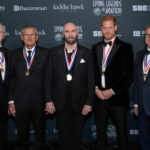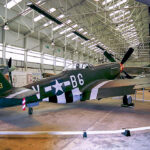By James Kightly, Commissioning Editor
The Shepherd is a 2023 British short film developed for Disney+. It is directed and written by Iain Softley and is based on the 1975 novella of the same name, by bestselling novelist Frederick Forsyth. It is online for streaming currently, here, or via your preferred local service.
The story for those not familiar, goes: “On Christmas Eve 1957, a young RAF pilot Freddie is flying home from Germany to England. He finds himself in peril when his radio and electric power cut out, leaving him stranded over the North Sea. Just when it appears his limited fuel – and his luck – is about to run out, a mysterious good Samaritan appears through the fog.” Released in December 2023, it’s a very topical Christmas movie, and we are able to take you behind the scenes to reveal how some of the magic with a ‘Vampire jet fighter’ was created.
Bruce Gordon is well known in British aviation preservation circles as a ‘go to’ guy on de Havilland aircraft and many other aspects of that British aviation era. Here, he takes over the story of how a Vampire was brought ‘back from the dead’. Read on:
“It started with a simple post on Facebook…’Wanted, single seat Vampire for film project.’ So I answered; and to be fair, there hadn’t been many options for the film company; there aren’t many about. Indeed, the only one was a fuselage, at one time with the RAF museum, and a collection of other parts. I spoke to the producer, who had already come to the same conclusion, and concluded a deal to buy it.

“You see, some 15 years or so previously, I had bought a warehouse full of aircraft parts, and I had gradually been selling them off. I had made a living out of it for a while, but it was winding down. But I did have what they were looking for. Oh, and did I also know where they might find a pair of wings? Hmm, well, yes, I could help with that too; I had a two seat Vampire project I was never going to finish, and did indeed have a pair of wings, albeit that they had been cut in half to facilitate transport. Ahem.”
“Oh, and last of all it was March 2022, and filming began in three weeks. That was a challenge! I started immediately; we bought fabric, dope, and other stuff, and I got in touch with friends to help get the thing together. The wings were collected from my shed, and brought up to Raynham. A local fabricator was brought in, and he set about joining them back together.”
“I got the fuselage recovered, and back up to silver dope, all to the original specifications. Even with the resurrected wings on hand, there was a lot missing. I had some of it, but more was needed. We got in touch with the de Havilland Aircraft Museum who were enormously helpful and opened their doors to us. Back in the day, I had worked there as a volunteer and had acquired a number of projects and parts for the future; all of which were sitting in a store. I headed over there, and we borrowed all the parts we needed to complete the Vampire.”
“By the time I returned from my shopping expedition, the team had assembled the kit of parts into something Vampire shaped, and we set about trying to make it look half way decent. Three days hard work culminated in a visit from John Travolta who was thrilled to see an aircraft of the type he once owned and flew. It was a surreal moment!”

“‘Our’ aeroplane wasn’t the only Vampire used on set. The only flying single seat Vampire in Europe (the Norwegian Air Historic Flight Vampire FB.52 LN-DHY) was flown into the long disused RAF Sculthorpe, and operated out of there for a few days. Also quite surreal. Sculthorpe is still used on occasion by the USAF, but only the runways survive – albeit they are the longest runways in the county – and only a stones throw from West Raynham. We also used a restored Venom cockpit owned by Tony Collins, and a partial cockpit supplied by Naylan Moore. At one point we sat Travolta in the Venom, and he loved it. ‘Greased lightning,’ he said, and we all laughed.”
“Anyway, three weeks after I started applying dope, we had a complete aeroplane, which looked great from about 10 feet away, and filming began in earnest. It was an interesting experience. My good friends Lyndon Blackburne and Charlotte Bailey deserve credit for dropping everything and coming over to help. Without them, we wouldn’t have had a Vampire, and the film would, in my opinion be the less for it. As of December 2023, the aircraft was still at Raynham; preserved for the time being, though far from perfect. But it’s what it is, and I’m delighted I concluded my career in vintage aircraft in this way.”
Thank you Bruce! The film was well received on release in 2023, and is streaming again this Christmas season. The book itself is well worth a read, and if you want to join in on a cultural icon, the Canadian Broadcasting Corporation (CBC) have a radio recording they present every Christmas since 1979 and, rightly, that’s very popular too.
There were a number of criticisms from old aviators who’d grown up on previous versions of the story, rather missing the point that no version is flawless. For instance their ‘fondly remembered’ book version’s illustrations – and even Forsythe’s as always meticulous research, aren’t entirely error free either. (For those interested, the book’s Bantam publisher illustration conflate two and single seat cockpits, while another technical expert was critical of how the electrical failure could topple a pressure driven altimeter.) But more importantly than these quibbles, the overall remarkably realistic feeling of the story came from Forsyth’s service in the RAF of the period, including flying similar types himself. For a new generation, it’s a worthy retake on a classic aviation story, and worth it for that alone. The care the teams took to achieve a significant level of authentic 1950s detail – not, notably – going for the easy WWII kit and context, deserves recognition. Whatever preservationists may think of the end result, money, effort and recognition went to supporting the ‘creation’ of a new de Havilland Vampire and a rare flying Vampire as well.
Backer and one of the film’s stars, John Travolta needs no introduction to our readers as a Hollywood giant. However it’s less well known that Travolta is a very experienced pilot, with a number of aircraft he has owned, and operated, over many years – not least his own single-seat, ex-Royal Canadian Air Force de Havilland Vampire F Mk.3 N6878D that he had between 1989 and 1995. He had optioned the story to film decades ago, but it never got to the top of the pile until recently. And he has a visceral relationship with Forsyth’s story from when he had a similar electrical failure in an aircraft he was flying, as he recounted to Variety: “I actually experienced a total electrical failure, not in a Vampire but in a corporate jet over Washington D.C.,” Travolta said. “So when I read [Forsyth’s] book, it resonated even more because of this experience I had personally had.”
He explained how much it was a passion project: “There’s very few projects I’ve ever been involved with that were locked in here,” Travolta said, indicating his heart. “I wanted to have a destiny with it for 30 years. It took 30 years but here I am tonight. But 30 years for me, fantasizing that we’d get this book done because there’s nothing like it I’ve seen.” See the book cover and watch the film’s trailer below:




































